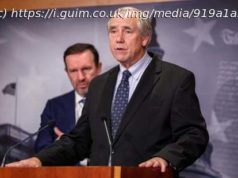St Patrick’s Day is celebrated on March 17 every year.
St Patrick is the patron saint of Ireland, credited with spreading Christianity across the Emerald Isle in the 5th century and establishing it as the dominant religion. What we know about Patrick comes largely from his written work Confessio.
Patrick was born in Roman-occupied Britain around the turn of the 5th century near to a place called Bannavem Taburniae, where his father, a deacon called Calpurnius, and grandfather, a priest called Potitus, lived.
The exact location of Bannavem Taburniae is not known, though it’s believed by some historians to be near Port Talbot in south Wales.
See all of the best photos of the week in these slideshows
Along with thousands of others, Patrick was kidnapped aged 16 by pirates from Ireland and taken there as a slave, where he herded sheep. While a slave, he became passionately religious.
People in fancy dress costumes walk past during the annual St. Patrick’s Day parade in Moscow on March 18,2017. VASILY MAXIMOV/AFP/Getty Images
“It was there that the Lord opened up my awareness of my lack of faith,” St Patrick wrote in Confessio. “Even though it came about late, I recognised my failings. So I turned with all my heart to the Lord my God, and he looked down on my lowliness and had mercy on my youthful ignorance.”
After six years of captivity, he heard a voice in a dream telling him that he would return to Britain and that his ship was ready, 200 miles away, and he ran away.
St Patrick made it back to Britain, and was eventually captured again, though freed shortly afterwards. He reunited with his parents, who begged him to stay, but he had a vision from someone called Victoricus, who carried letters from Ireland and gave him one. It begged him to return.
It’s thought Patrick travelled to France to study under St Germain, the bishop of Auxerre, and was eventually ordained before he set off as a fully-fledged Catholic missionary.
St Patrick travelled around Ireland preaching the Christian faith, trying to convert all he met, baptising people along the way and establishing new churches, eventually becoming a bishop himself.
“How has this happened in Ireland?” he wrote in Confessio. “Never before did they know of God except to serve idols and unclean things. But now, they have become the people of the Lord, and are called children of God. The sons and daughters of the leaders of the Irish are seen to be monks and virgins of Christ!”
Patrick suffered much during these decades of preaching around Ireland. “At times I gave gifts to kings, over and above what I paid to their sons who travelled with me,” he wrote. “Despite this, they took me and my companions prisoner, and very much wanted to kill me, but the time had not yet come. They stole everything they found in our possession, and they bound me in iron.”
Spectators take a selfie as they attend the St Patrick’s Day parade in Dublin on March 17,2015. This year’s festivities include parades and 10K runs. PAUL FAITH/AFP/Getty Images
The exact date of Patrick’s death is unknown and the two potential times it took place are around 30 years apart, the first being around 460, the second around 490. It’s thought he died on March 17—which is why that’s his feast day, St Patrick’s Day, and is celebrated every year.
Confessio and another contemporary text written by Patrick, his letter to Coroticus, are the only historical evidence of the real Patrick. However, a number of popular myths and legends were created in the hundreds of years after his death.
Among those are stories is one of him using the shamrock— Ireland’s national symbol —in his preaching to convert pagans. Another claims he banished all the snakes from Ireland by chasing them into the sea, which is why there aren’t any left slithering around.
The 7th century monk and Irish historian Muirchú, the biographer of St Patrick, is to blame for much of the cultural mythology surrounding him. He wanted to create a unifying symbol of Irishness and, to him, Patrick was the perfect national figurehead.






